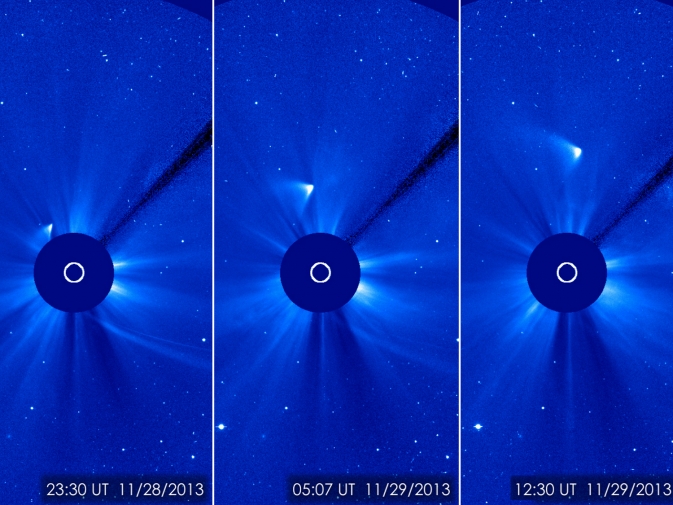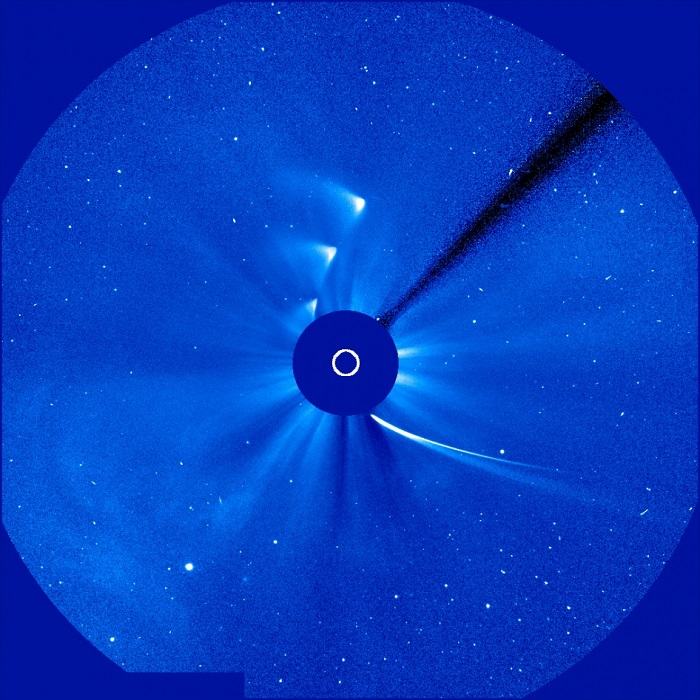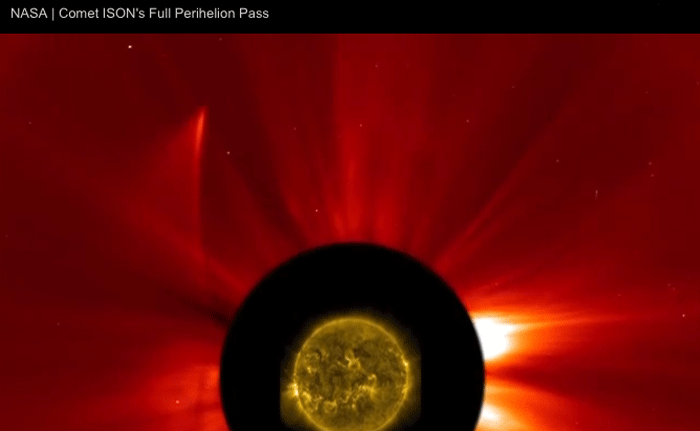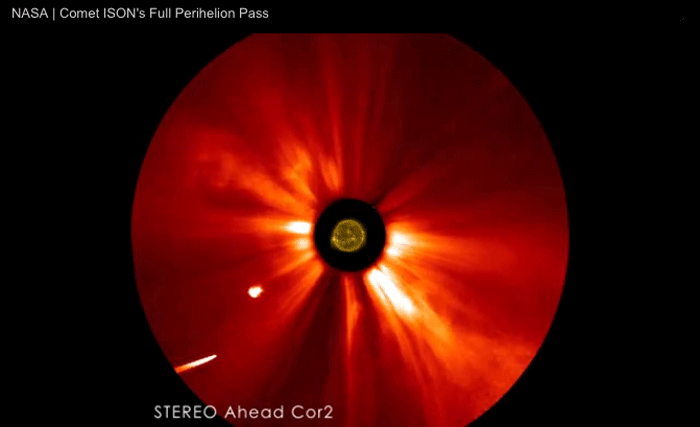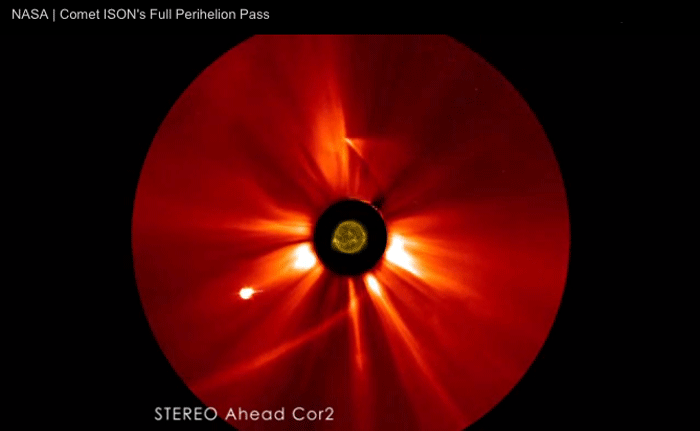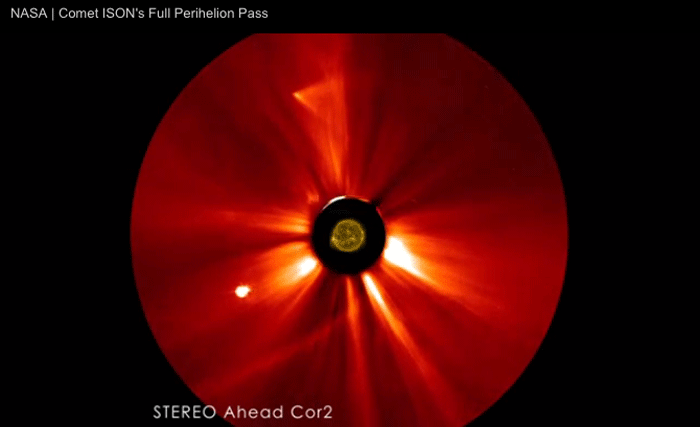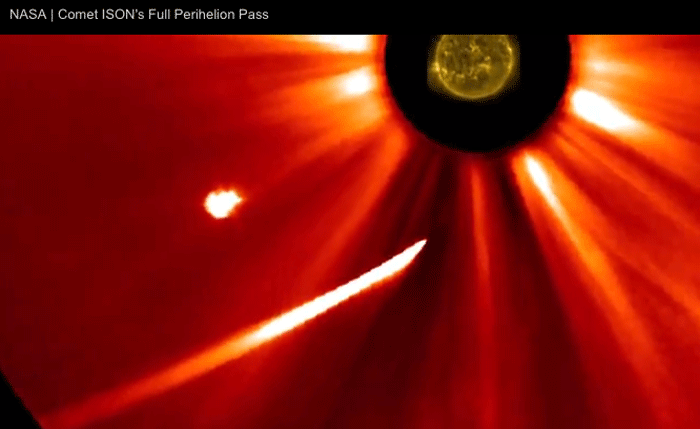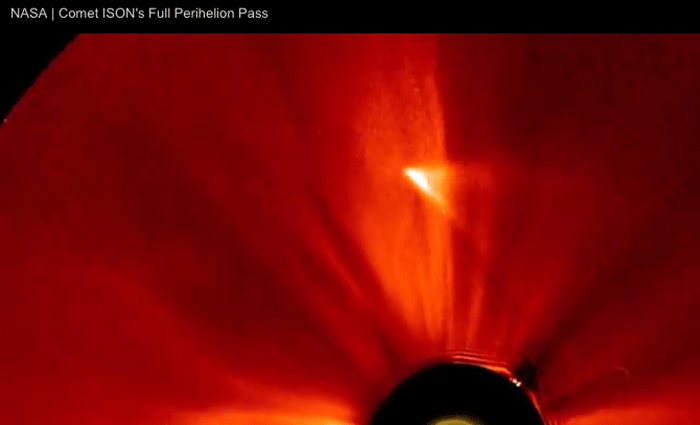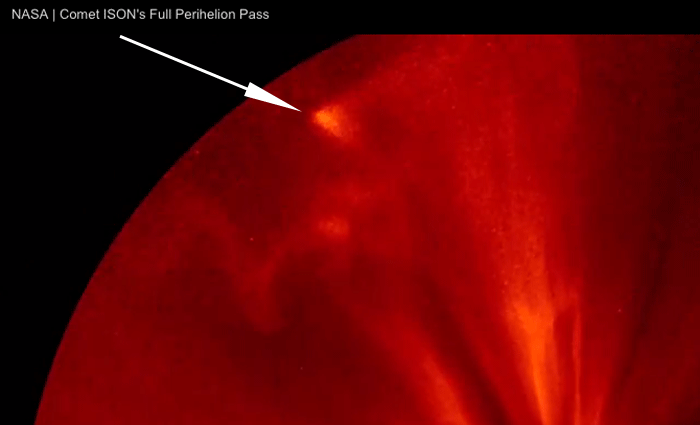.
Continuing a history of surprising behavior, material from Comet ISON appeared on the other side of the sun on the evening on Nov. 28, 2013, despite not having been seen in observations during its closest approach to the sun. The question remains whether it is merely debris from the comet, or if some portion of the comet's nucleus survived, but late-night analysis from scientists with NASA's Comet ISON Observing Campaign suggest that there is at least a small nucleus intact.
Comet ISON Seen Coming and Going
This time-lapse image shows Comet ISON approaching and leaving during its slingshot around the sun – represented by the white circle -- on Nov. 28, 2013. The ISON images clearly outline the curve of the comet's orbit path. The images were captured by ESA/NASA's SOHO mission. Credit: ESA/NASA/SOHO/SDO/GSFC
Quelle: NASA
.
Update: 18.15 MEZ
Wait! Comet ISON May Live On
It was thought to have died, but now it appears comet ISON lives on to fight another da
In the battle "Fire vs ISON," last night appeared to have declared fire—or the sun—the victor, but new images out this morning show ISON is still intact.
In a tweet posted by NASA this morning, new images show that ISON did reappear following its slingshot around the sun. "Is it or isn't it? New data indicates it may have survived," NASA tweeted.
"My reaction was 'Wow, this is crazy,'" solar physicist Alex Young of Goddard Space Flight Center told ABC News.
The comet ISON, named after the International Scientific Optical Network which discovered it last year, made its closest approach to the sun Thursday at 1:37 p.m. ET.
But on Thursday, toward the end of a live NASA-hosted Google+ Hangout to answer questions about ISON on Thursday, Young had said it was "unfortunate that it doesn't appear that we'll see it."
Young speculated that the comet "was not stable enough or perhaps the gravity from the sun [was the cause]" of the comet's disappearing Thursday evening. Adding that even if it had disintegrated, it still would offer a glimpse into how comets interact with the sun's magnetic fields.
Last night, NASA tweeted poignantly, "Like Icarus, #comet #ISON may have flown too close to the sun." But today Young tells ABC News that there were a couple of reasons why they thought the comet had died. Mainly it was the inability to see it from the Solar Dynamics Observatory (SDO). Launched in 2010, the NASA spacecraft SDO watches the sun round-the-clock, capturing high-definition images of the sun's atmosphere with a level of detail not seen before.
"We were monitoring the data from SDO. We had seen two comets before as [they] passed through the sun's atmosphere with SDO that were 10 times smaller than ISON. Based on past experience, it gave us a pretty good idea we should see it this time too," Young explained. "Given the fact that we didn't see it—we didn't see anything when it was passing closest to the sun in SDO—we just concluded that it probably hadn't made it."
When initial data started to come out, scientists thought it was remnants of the tail. Only upon further examination did they realize the comet was still intact.
"We were pretty sure that it was gone, and my second thought was, What in the world happened? Why didn't we see it in SDO?" Young said. "Now there is this mystery. Is there something different about the comet's composition?"
The previous two comets spotted with SDO were 10 times smaller and passed much closer to the sun. ISON, however, passed the sun at a much greater distance and passed by a different magnetic field. SDO tracks comets based on the gasses emitted from the comet and therefore the "light it gives off."
"You have to have enough oxygen and iron. They get really hot and when they do they start glowing, they put out a certain wave length of light. If they aren't putting out enough of that light, because of its makeup, you just won't see it [on SDO]," Young explained.
"Main thing is we now have this puzzle and fill in the pieces and figure out what is going on," Young said. "We were pretty disappointed we didn't see this great imagery through SDO but at the same time it gives us another great scientific mystery to figure out, and I guess that is why we do this."
The comet's journey took it approximately 730,000 miles away from the sun's surface.
Skygazers can plan on seeing the comet come Dec 1. "It would be low in the sky early in the morning," Young said. "Each day it will go higher in the sky and be visible earlier in the morning, closer to midnight. By the 17th it will be up or around the Big Dipper and should be visible closer to midnight."
Quelle: abc-news
.
Update: 1.12.2013
.
ISON stellt Staubproduktion ein
Auf aktuellen Bildern wird der Schweifstern zunehmend lichtschwächer
.
Der Komet ISON hatte am Donnerstagabend zum Zeitpunkt seiner größten Sonnenannäherung noch einen aktiven Kern, der Gas und Staub spuckte. Etwa zwei Stunden nach der Perihelpassage fanden sich jedoch keine Anzeichen mehr für eine Produktion. Zu dieser Einschätzung kommen Wissenschaftler des Max-Planck-Instituts für Sonnensystemforschung in Katlenburg-Lindau am heutigen Samstag. Sie analysierten Bilder des Instruments Lasco, das an Bord des Sonnenobservatoriums Soho einen einzigartigen Blick auf den Schweifstern genießt. Auf aktuellen Aufnahmen nimmt die Helligkeit des offenbar inaktiven Kometen allmählich ab. Eine große Kometenshow wird es mit ziemlicher Sicherheit nicht mehr geben.
Gegen 20.30 Uhr am Donnertagabend tauchte der Schweif von ISON nach seiner Sonnenpassage wieder im Gesichtsfeld des Instruments Lasco auf. Zu diesem Zeitpunkt war aber unklar, ob sich an der Spitze des Schweifs noch ein Kometenkern verbirgt oder nicht. Aufnahmen, die mehrere Stunden nach dem Perihel gewonnen wurden, lassen weitergehende Schlüsse zu.
„Der Staubschweif des Kometen zeigt sich nun zweigeteilt“, beschreibt Hermann Böhnhardt vom Max-Planck-Institut für Sonnensystemforschung die Bilder. Der Teil des Schweifs, der in Richtung Sonne zeigt, besteht laut Böhnhardt aus Staubteilchen, die deutlich vor der Perihelpassage – also vor dem Erreichen des sonnennächsten Bahnpunkts – freigesetzt wurden.
Der andere Teil dagegen enthält offenbar jüngeres Material: Es wurde während des Vorbeiflugs emittiert und deutet darauf hin, dass zu diesem Zeitpunkt zumindest noch ein Teil des Kerns existierte und aktiv war.
Die Max-Planck-Forscher stützen ihre Einschätzung auf Computersimulationen, in denen sie die Form des Staubschweifs modellieren. „Wenn wir in unseren Rechnungen annehmen, dass der Komet im Perihel noch Staub emittiert hat, können wir die aktuellen Aufnahmen gut reproduzieren“, sagt Böhnhardt.
Die Lasco-Bilder vom Samstag zeigten dann, dass ISON zwei Stunden nach der Perihelpassage seine Staubproduktion eingestellt hatte. Ob der Kometenkern im Perihel noch intakt war oder seinen Weg als kleines Bruchstück oder als Ensemble von Fragmenten fortsetzte, steht noch nicht fest.
Das Instrument Sumer an Bord des Satelliten Soho, das unter Leitung des Lindauer Max-Planck-Instituts entwickelt und gebaut wurde, beobachtete gestern Abend ISON in der Stunde seiner direkten Sonnenannäherung. Das Instrument spaltet das Licht, das der Himmelskörper ins All sendet, in seine einzelnen Bestandteile auf. Daraus können Forscher auf Elemente und Moleküle in der Staubwolke des Kometen schließen.
„Unsere Messungen zeigen ein klares Signal des Kometen während des Sonnenvorbeiflugs“, sagt Max-Planck-Wissenschaftler Werner Curdt. Genaue Ergebnisse der Messungen lägen jedoch noch nicht vor.
Quelle: MAX-PLANCK-GESELLSCHAFT, MÜNCHEN
.
Update: 13.00 MEZ
.
SoHo-Aufnahmen von ISON:
.
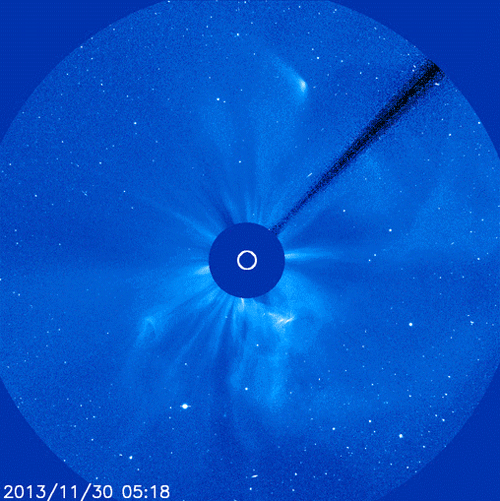
.
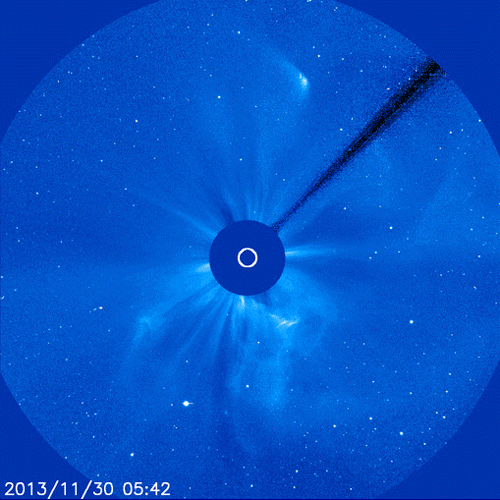
.
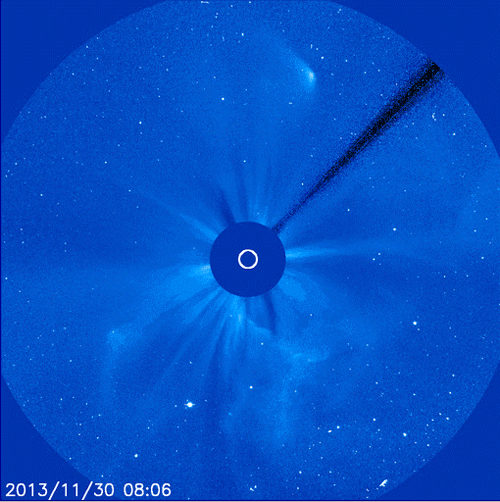
.
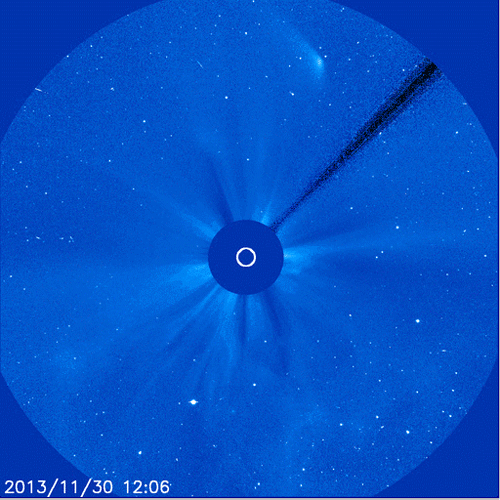
.
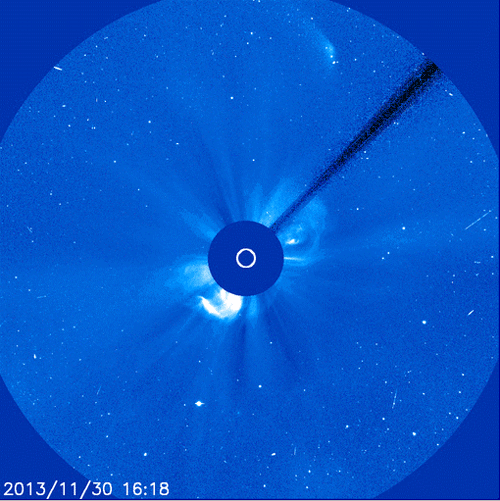
.
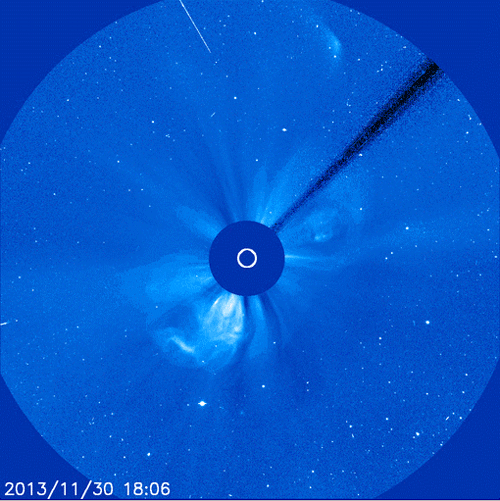
.
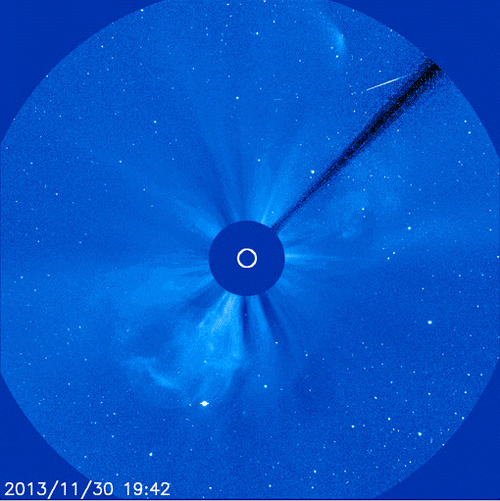
.
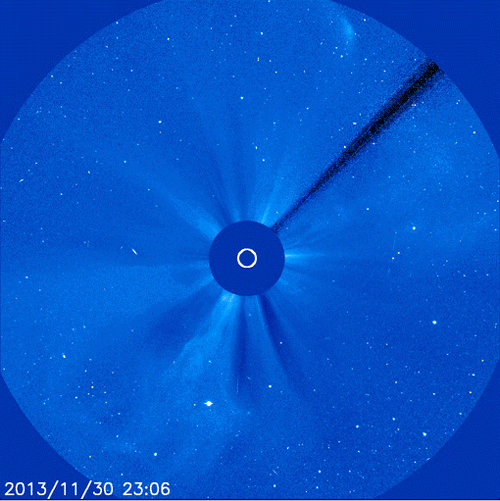
.
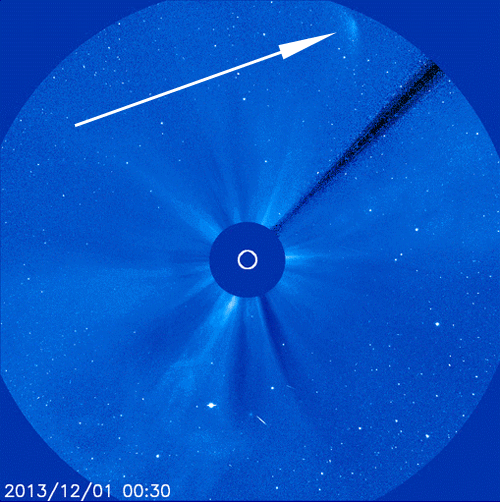
Quelle: NASA
.
Update: 2.12.2013
.
NASA Investigating the Life of Comet ISON
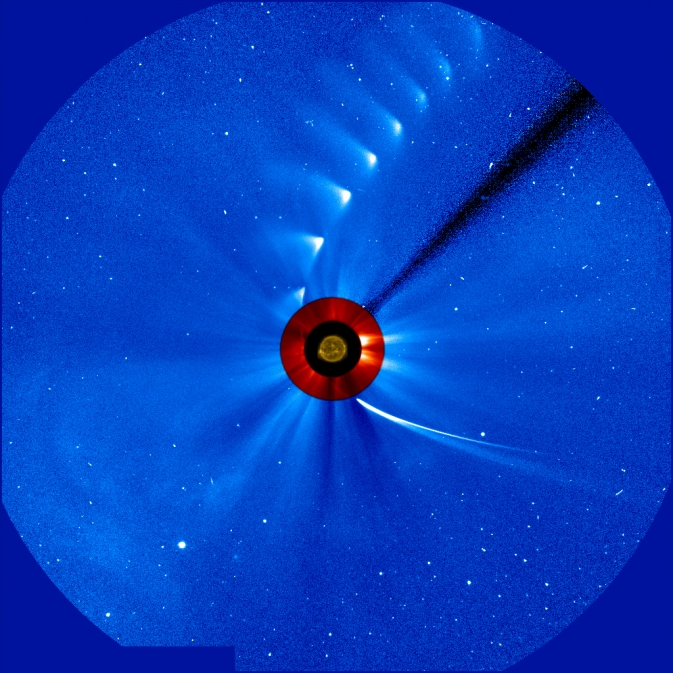
Comet ISON comes in from the bottom right and moves out toward the upper right, getting fainter and fainter, in this time-lapse image from the ESA/NASA Solar and Heliospheric Observatory. The image of the sun at the center is from NASA's Solar Dynamics Observatory.
Image Credit: ESA/NASA/SOHO/SDO/GSFC
.
After several days of continued observations, scientists continue to work to determine and to understand the fate of Comet ISON: There's no doubt that the comet shrank in size considerably as it rounded the sun and there's no doubt that something made it out on the other side to shoot back into space. The question remains as to whether the bright spot seen moving away from the sun was simply debris, or whether a small nucleus of the original ball of ice was still there. Regardless, it is likely that it is now only dust.
Comet ISON, which began its journey from the Oort Cloud some 3 million years ago, made its closest approach to the sun on Nov. 28, 2013. The comet was visible in instruments on NASA's Solar Terrestrial Relations Observatory, or STEREO, and the joint European Space Agency/NASA Solar and Heliospheric Observatory, or SOHO, via images called coronagraphs. Coronagraphs block out the sun and a considerable distance around it, in order to better observe the dim structures in the sun's atmosphere, the corona. As such, there was a period of several hours when the comet was obscured in these images, blocked from view along with the sun. During this period of time, NASA's Solar Dynamics Observatory could not see the comet, leading many scientists to surmise that the comet had disintegrated completely. However, something did reappear in SOHO and STEREO coronagraphs some time later – though it was significantly less bright.
.
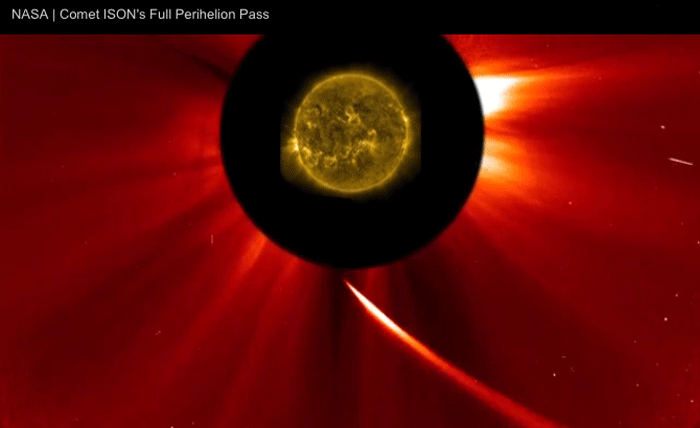
Comet ISON is shown approaching the sun and curving away from it in this movie containing imagery from both NASA's Solar Terrestrial Relations Observatory and the joint ESA/NASA Solar and Heliospheric Observatory from November 2013. ISON dims dramatically as it streams away from the sun.
Image Credit: ESA/NASA/SOHO/STEREO/GSFC
.
.
.
.
.
.
.
.
Whether that spot of light was merely a cloud of dust that once was a comet, or if it still had a nucleus – a small ball of its original, icy material – intact, is still unclear. It seems likely that as of Dec. 1, there was no nucleus left. By monitoring its changes in brightness over time, scientists can estimate whether there's a nucleus or not, but our best chance at knowing for sure will be if the Hubble Space Telescope makes observations later in December 2013.
Regardless of its fate, Comet ISON did not disappoint researchers. Over the last year, observatories around the world and in space gathered one of the largest sets of comet observations of all time, which should provide fodder for study for years to come. The number of space-based, ground-based, and amateur observations were unprecedented, with twelve NASA space-based assets observing over the past year.
.
Quelle: NASA
.
ISON-Remember
.
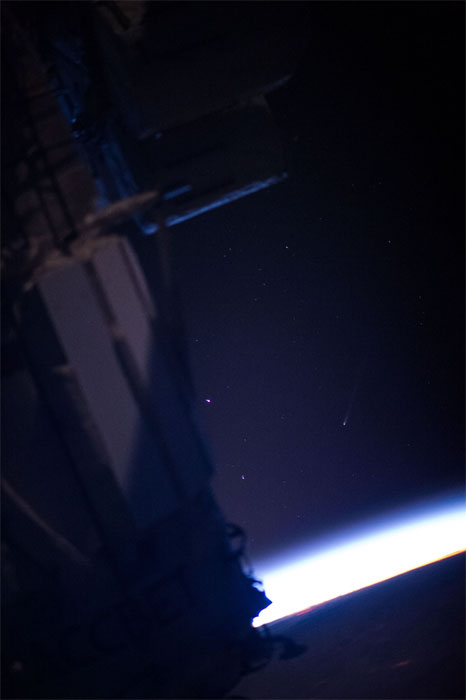
Comet ISON Spotted From Space Station
ISS038-E-007980 (23 Nov. 2013) --- A close inspection of this image, photographed by one of the Expedition 38 crew members aboard the International Space Station, reveals a pin-head sized view of an object which is actually the comet ISON, seen just to the right of center and a little below center in the frame. Hardware components of the orbital outpost and Earth's atmosphere above the horizon take up most of the image. Most of the other bright dots in the sky are heavenly bodies. The comet is distinguishable by its tail.
Photo credit: NASA
.
Update: 10.12.2013
.
COMET ISON UPDATE: Later this month, NASA plans to point the Hubble Space Telescope at Comet ISON to see if anything remains after the comet's death plungethrough the sun's atmosphere on Nov. 28th. Note to Hubble: Don't expect to see much. Amateur astronomers are already searching the comet's position and setting hard limits on the brightness of any remains. Consider this image taken on Dec. 8th by Eric Allen of the Observatoire du Cégep de Trois-Rivières in Champlain, Québec:
.
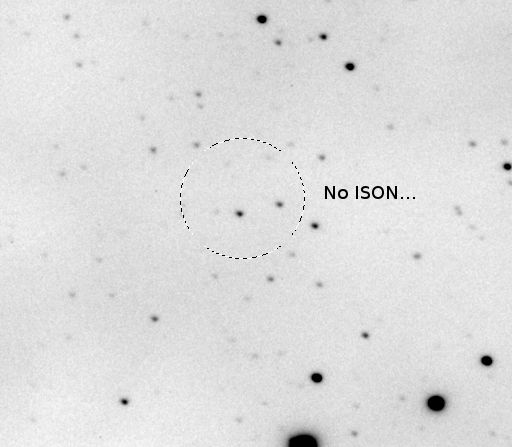
The position of the comet--had it survived--is circled. "I unfortunately have to say that there is nothing down to about magnitude +16.5, not even a small condensation," says Allen.
As Karl Battams of the Naval Research Lab comments in his blog on the Comet ISON Observing Campaign web site: "The evidence appears strong that at some point approaching perihelion Comet ISON likely began to completely fall apart. What remains of ISON now is going to be either just a cloud of dust, or perhaps a few very depleted chunks of nucleus. Either way, it's not going to flare up at this point and we should assume the comet's show is over."
Quelle: Spaceweather
